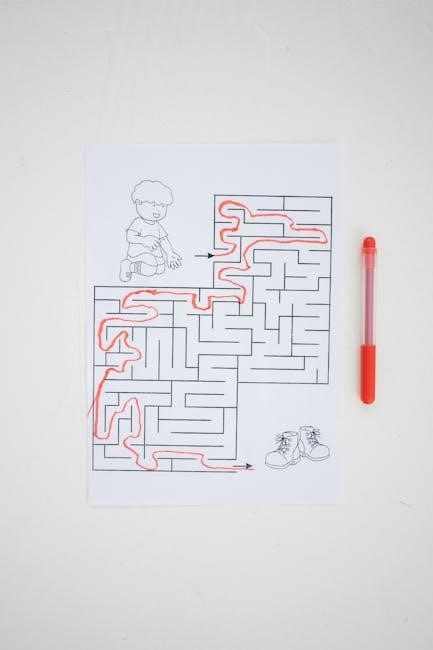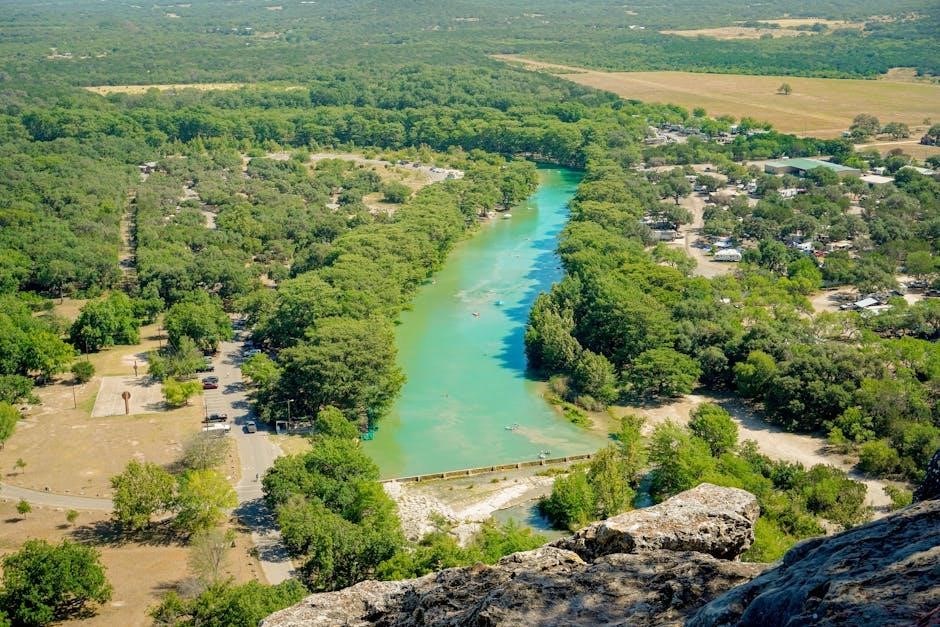The water cycle is Earth’s vital process circulating water through evaporation, condensation, and precipitation. Printable worksheets offer engaging tools for students to explore and understand this cycle.
1.1 What is the Water Cycle?
The water cycle, also known as the hydrologic cycle, is the continuous process by which water moves through Earth’s systems. It involves evaporation, where water turns into vapor; condensation, forming clouds; precipitation, where water falls back to Earth; and collection, as water gathers in oceans, lakes, and groundwater. This cycle sustains life and regulates Earth’s climate. Printable worksheets simplify learning by breaking down these stages into interactive activities, helping students visualize and understand the water cycle’s essential role in our ecosystem.

1.2 Importance of the Water Cycle in Earth’s Ecosystem
The water cycle is vital for sustaining life on Earth, regulating climate, and maintaining ecosystems. It ensures water distribution, supports plant growth, and influences weather patterns. Without it, life as we know it would cease. Printable worksheets help students grasp its significance, highlighting how it connects oceans, land, and atmosphere. Understanding the water cycle fosters appreciation for Earth’s natural processes and the need for conservation. It also explains how human activities impact water availability, making it a cornerstone of environmental education.

Printable Water Cycle Worksheets
Printable water cycle worksheets are essential tools for educating students about Earth’s hydrologic processes. They offer interactive activities like labeling diagrams, fill-in-the-blanks, and sequencing exercises to enhance learning and engagement.
2.1 Overview of Printable Worksheets
Printable water cycle worksheets provide a comprehensive learning experience, offering a variety of activities such as diagrams, fill-in-the-blanks, and sequencing exercises. These resources are designed to engage students with interactive tasks, making the water cycle concept easy to grasp. Available in PDF formats, they cater to different grade levels, ensuring age-appropriate content. Many worksheets include visual aids and step-by-step guides, while others offer creative activities like labeling diagrams or matching terms. These tools are versatile, suitable for both classroom use and home learning, making them a valuable resource for educators and parents alike.
2.2 Benefits of Using Printable Worksheets for Learning
Printable water cycle worksheets offer numerous benefits for learning. They provide structured, interactive activities that enhance retention and understanding of the water cycle process. Worksheets cater to different learning styles, with visual aids, fill-in-the-blanks, and sequencing exercises. They also serve as valuable assessment tools, helping teachers gauge student comprehension. Additionally, printable worksheets are cost-effective, reusable, and easily accessible, making them ideal for both classroom and home learning environments. By incorporating hands-on activities, they make complex concepts like evaporation and condensation more engaging and relatable for students of all ages.
2.3 Popular Types of Water Cycle Worksheets
Popular types of water cycle worksheets include fill-in-the-blank exercises, labeling diagrams, and sequencing activities. These tools help students identify and organize the stages of the water cycle. Additionally, matching games and crossword puzzles reinforce vocabulary related to evaporation, condensation, and precipitation. Some worksheets feature colorful diagrams for labeling, while others incorporate hands-on crafts, such as foldable activities, to make learning interactive. Worksheets with sequencing exercises allow students to arrange the water cycle stages in order, enhancing their understanding of the process. These varied formats cater to different learning styles, making the water cycle engaging and accessible for all students.

Key Components of the Water Cycle
The water cycle’s key components include evaporation, condensation, precipitation, and collection. These processes continuously circulate water, essential for Earth’s ecosystems and climate regulation.
3.1 Evaporation: The Starting Point
Evaporation initiates the water cycle as the sun heats water in oceans, lakes, and rivers, turning it into vapor. This process is crucial for atmospheric water supply.

3.2 Condensation: Formation of Clouds
Condensation occurs as water vapor cools in the atmosphere, forming tiny droplets that create clouds. Printable worksheets often include diagrams and activities to help students visualize this process, making it easier to understand how clouds form and prepare for precipitation. These resources encourage interactive learning, allowing students to label cloud types and track the movement of water vapor. By engaging with these materials, students gain a deeper appreciation for the crucial role condensation plays in the water cycle and how it connects to other processes like precipitation and evaporation.
3.3 Precipitation: Water Returning to Earth
Precipitation occurs when water droplets in clouds combine and fall to Earth as rain, snow, sleet, or hail. This process is essential for replenishing water sources and sustaining life. Printable worksheets often include diagrams and exercises to help students identify and describe different types of precipitation. These resources also highlight how precipitation connects to other water cycle stages, such as evaporation and condensation, making it easier for learners to grasp the continuous flow of water in the environment.

3.4 Collection: Water Storage andReuse
3.4 Collection: Water Storage and Reuse
Collection is the final stage of the water cycle, where water is stored in oceans, lakes, rivers, and groundwater. Printable worksheets often feature activities that help students understand how water is distributed and reused. These resources include fill-in-the-blank exercises and labeling diagrams to illustrate storage mechanisms. Worksheets also emphasize the importance of water conservation, showing how human actions can impact storage and reuse processes. By engaging with these materials, students gain a deeper appreciation for the water cycle’s sustainability and its role in Earth’s ecosystems.

Interactive Water Cycle Activities
Interactive activities enhance learning through hands-on engagement. Fill-in-the-blank exercises, labeling diagrams, and sequencing stages are popular. These tools make understanding the water cycle fun and memorable for students.
4.1 Fill-in-the-Blank Exercises
Fill-in-the-blank exercises are a popular method for reinforcing water cycle concepts. Students complete sentences by inserting key terms like “evaporation” or “condensation.” These activities enhance vocabulary retention and understanding of processes. Worksheets often include visual cues or diagrams to guide learners. This interactive approach makes learning engaging and effective for various age groups. By filling in the blanks, students actively participate in constructing their knowledge, leading to better retention of the water cycle’s fundamental stages and mechanisms.
4.2 Labeling Diagrams
Labeling diagrams are an interactive way to teach the water cycle. Students identify and label key components like evaporation, condensation, and precipitation; These diagrams visually represent the process, making complex concepts easier to grasp. Worksheets often include illustrations of clouds, oceans, and landscapes, allowing learners to connect terms with their respective stages. This hands-on activity improves retention and understanding of the cycle’s sequence. Printable PDFs and online tools like Google Forms offer customizable labeling exercises, catering to different learning styles and ages, ensuring an engaging and educational experience for all students.
4.3 Sequencing the Water Cycle Stages
Sequencing activities help students organize the water cycle stages in order. Worksheets often provide terms like evaporation, condensation, and precipitation for students to arrange chronologically. This exercise enhances understanding of cause-and-effect relationships within the cycle. Interactive PDFs and Google Forms offer drag-and-drop features, making the task engaging.Visual aids like diagrams and arrows guide learners to place events correctly. Sequencing fosters critical thinking and retention of the water cycle’s continuous process. It also helps students visualize how water moves from the Earth to the atmosphere and back, reinforcing the cycle’s natural flow and interconnectedness. This activity is both educational and enjoyable.
Educational Resources for Teachers
Teachers can access free PDF worksheets, teacher guides, and lesson plans to effectively teach the water cycle. Online tools and interactive activities enhance classroom learning experiences.
5.1 Free PDF Worksheets for Grade 1-2
Free PDF worksheets designed for Grade 1-2 students offer a fun and interactive way to learn about the water cycle. These resources include colorful diagrams, simple language, and engaging activities like fill-in-the-blank exercises and labeling tasks. Worksheets are tailored to young learners, focusing on basic concepts such as evaporation, condensation, and precipitation. Many resources, like those from Itsy Bitsy Fun, provide teacher guides to support instruction. These PDFs are easily downloadable and align with elementary science curricula, making them a valuable tool for introducing the water cycle in an age-appropriate manner.

5.2 Teacher Guides and Lesson Plans
Teacher guides and lesson plans complement printable water cycle worksheets, offering structured approaches for educators. These resources include detailed instructions, activity ideas, and assessments to align with curriculum goals. Many guides incorporate interactive elements, such as Google Forms and Easel Activities, to enhance student engagement. Lesson plans often cover key concepts like evaporation and precipitation, providing practical tools for teachers to deliver effective science lessons. By integrating worksheets with comprehensive teaching materials, educators can ensure a well-rounded understanding of the water cycle for their students, supporting both classroom and remote learning environments.
5.3 Online Tools for Interactive Learning
Online tools enhance water cycle education with interactive features like Google Forms and digital worksheets. These platforms allow students to engage with diagrams, sequencing activities, and fill-in-the-blank exercises virtually. Teachers can track progress and provide feedback easily, making learning dynamic and accessible. Such tools cater to diverse learning styles, fostering a deeper understanding of the water cycle. They also support remote learning, ensuring educational continuity and student engagement in a digital age. These resources are invaluable for modern classrooms aiming to integrate technology with traditional teaching methods.

Engaging Students with Water Cycle Worksheets
Interactive worksheets, like fill-in-the-blank and labeling exercises, make learning the water cycle fun and hands-on, helping students grasp key concepts through visual and active engagement.
6.1 Hands-On Activities for Better Retention
Hands-on activities, such as fill-in-the-blank exercises and labeling diagrams, enhance student engagement and retention. Printable worksheets with interactive elements, like sequencing the water cycle stages, make learning dynamic. These activities allow students to visualize and interact with concepts, fostering a deeper understanding. For younger grades, foldable crafts and color-by-process worksheets simplify complex ideas. Older students benefit from detailed diagrams and critical thinking exercises. Interactive PDFs and Google Forms also provide a modern, tech-integrated approach. These varied activities cater to different learning styles, ensuring all students can effectively grasp and retain water cycle knowledge.
6.2 Incorporating Visual Aids
Visual aids like diagrams, charts, and illustrations in printable worksheets enhance learning by providing a clear, tangible representation of the water cycle. Labeling activities allow students to identify key processes such as evaporation, condensation, and precipitation. Colorful diagrams and foldable crafts make abstract concepts more engaging, especially for younger learners. Visual aids also help students connect theoretical knowledge with real-world observations, making the water cycle more relatable and easier to understand. By integrating images and interactive elements, worksheets cater to visual learners and reinforce retention of complex scientific concepts.
6.3 Assessing Student Understanding
Printable water cycle worksheets include assessments to evaluate student comprehension. Fill-in-the-blank exercises, true/false questions, and diagram labeling tests help gauge understanding. These tools allow teachers to identify knowledge gaps and provide targeted support. Worksheets often feature answer keys for easy grading, ensuring accuracy. Interactive activities, like sequencing the water cycle stages, reinforce learning and retention. By incorporating quizzes and review sections, educators can track student progress effectively. Such assessments align with curriculum standards, making them invaluable for classroom use and student evaluation.
Advanced Topics in the Water Cycle
Advanced topics explore transpiration, runoff, and human impact on water distribution. Printable worksheets delve into these complex processes, highlighting their significance in Earth’s hydrological system.

7.1 Transpiration and Its Role
Transpiration is a critical process where plants release water vapor into the atmosphere through their leaves. This process is essential for plant growth and cooling. It contributes significantly to the water cycle by returning a substantial amount of water to the atmosphere, which later forms clouds and precipitation. Printable worksheets often include diagrams and activities to help students visualize and understand the role of transpiration. These resources emphasize how transpiration interacts with other water cycle components, such as evaporation and condensation, to maintain Earth’s hydrological balance. Engaging with these materials enhances students’ grasp of this vital ecological process.
7.2 Runoff and Infiltration Processes
Runoff and infiltration are key processes in the water cycle; Runoff occurs when water flows over land into bodies of water, while infiltration is water seeping into the soil. Both processes are crucial for maintaining water balance, supporting ecosystems, and replenishing groundwater. Printable water cycle worksheets, such as PDFs, provide interactive activities and diagrams to help students understand these processes. By engaging with these resources, students can better grasp how runoff and infiltration contribute to the continuous movement of water on Earth, ensuring a sustainable water supply.
7;3 Human Impact on the Water Cycle
Human activities significantly influence the water cycle, altering natural processes like evaporation and precipitation. Deforestation, urbanization, and pollution disrupt water distribution, affecting ecosystems. Printable worksheets help students explore these impacts, offering activities to identify human effects on water cycle stages. Resources include diagrams linking deforestation to reduced evaporation and exercises matching terms like “pollution” with cycle disruptions. These tools enable interactive learning, fostering awareness of human-induced changes and encouraging sustainable practices. By engaging with these materials, students gain insights into mitigating negative impacts, promoting environmental stewardship and water conservation efforts globally.
Printable water cycle worksheets offer engaging, educational tools for learning. They enhance understanding through interactive activities, making complex concepts accessible for students of all ages and skill levels.
8.1 Summary of Key Points
Printable water cycle worksheets provide a comprehensive learning experience, covering key stages like evaporation, condensation, and precipitation. They include fill-in-the-blank exercises, labeling diagrams, and sequencing activities. Designed for various grade levels, these resources are ideal for interactive learning. Visual aids and hands-on tasks enhance retention, while free PDF options offer accessibility. Teachers can complement these worksheets with lesson plans and online tools for a well-rounded educational approach. Such materials not only simplify complex concepts but also foster a deeper understanding of Earth’s water system.
8.2 Encouraging Further Exploration
Exploring the water cycle beyond worksheets can deepen understanding. Encourage students to observe natural processes like rain formation or plant transpiration. Interactive tools, such as online simulations or educational videos, can enhance learning. Field trips to lakes or forests can provide real-world insights. Discussing human impacts, like conservation efforts, fosters critical thinking. Encourage students to create projects, such as models or presentations, to share their knowledge. These activities inspire curiosity and promote a lifelong appreciation for Earth’s water systems, preparing students to contribute to environmental stewardship.

No Responses